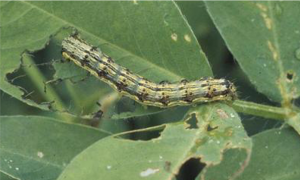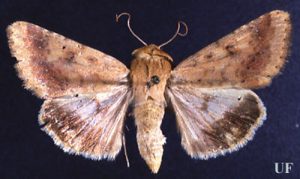Caterpillars are a common pest of vegetable plants. They can reduce fruit quality and yield by feeding on leaves or fruit. One important caterpillar pest is the corn earworm (Helicoverpa zea). This caterpillar develops into a relatively harmless nondescript moth, but the caterpillar causes major crop damage in corn and tomato. It is also known as the tomato fruitworm, cotton bollworm, soybean podworm, and sorghum headworm. Some experts consider it one of the most damaging pests in the United States.
Identification
Identification of caterpillars can be difficult and may require the assistance of an expert. Caterpillar body color is variable and can change as it grows older. They can be brown, green, or even pink. There is usually a pair of narrow stripes that run down the back. There is also usually a white net pattern on the head. Adults are also difficult to identify. They have brown to yellow forewings with a dark spot in the center.


Damage
The corn earworm has a wide host range and feeds on a variety of plants, but corn and tomatoes are its favorite. It causes serious damage when it feeds on corn silk and kernels and tomato fruit. In corn, eggs are laid on silk and the caterpillar hatches and can feed on silk and kernels. In tomato, eggs are laid on leaves, flowers, or fruit. The caterpillar feeds by burrowing into tomato fruit. The corn earworm prefers warmer climates. Adult moths migrate north from southern states and can overwinter as far north as Ohio and Kansas.
Lookalike
The corn earworm is established in the United States, but it looks identical to the old world bollworm (Helicoverpa armigera) which is considered an invasive pest. In order to distinguish the two species, DNA molecular analysis or dissections must to be performed by an expert. If you find a caterpillar that you are unsure is the corn earworm or the invasive old world bollworm, contact the FDACS-DPI help line at: DPIHelpline@FDACS.gov or 1-888-397-1517.
 0
0
